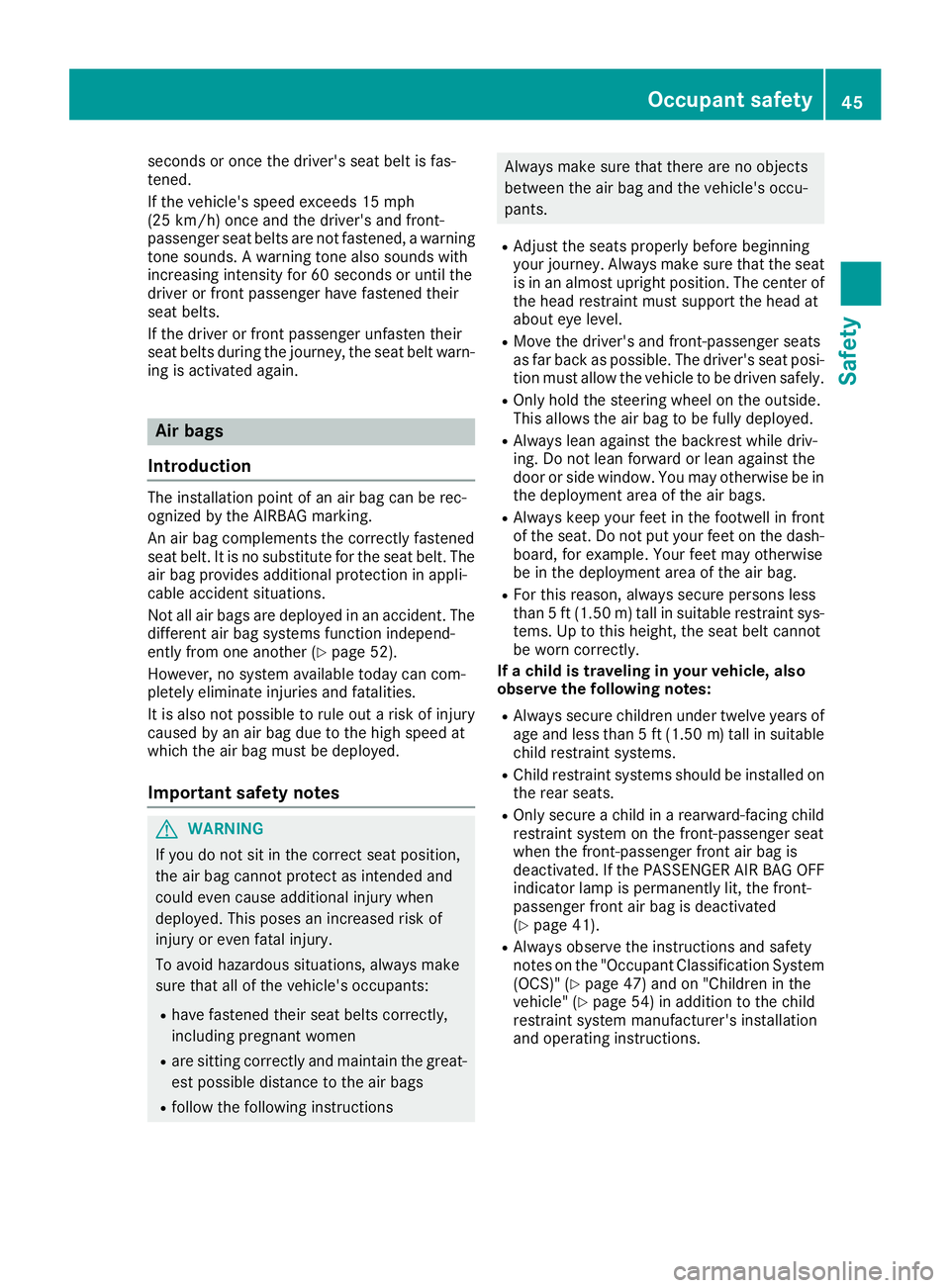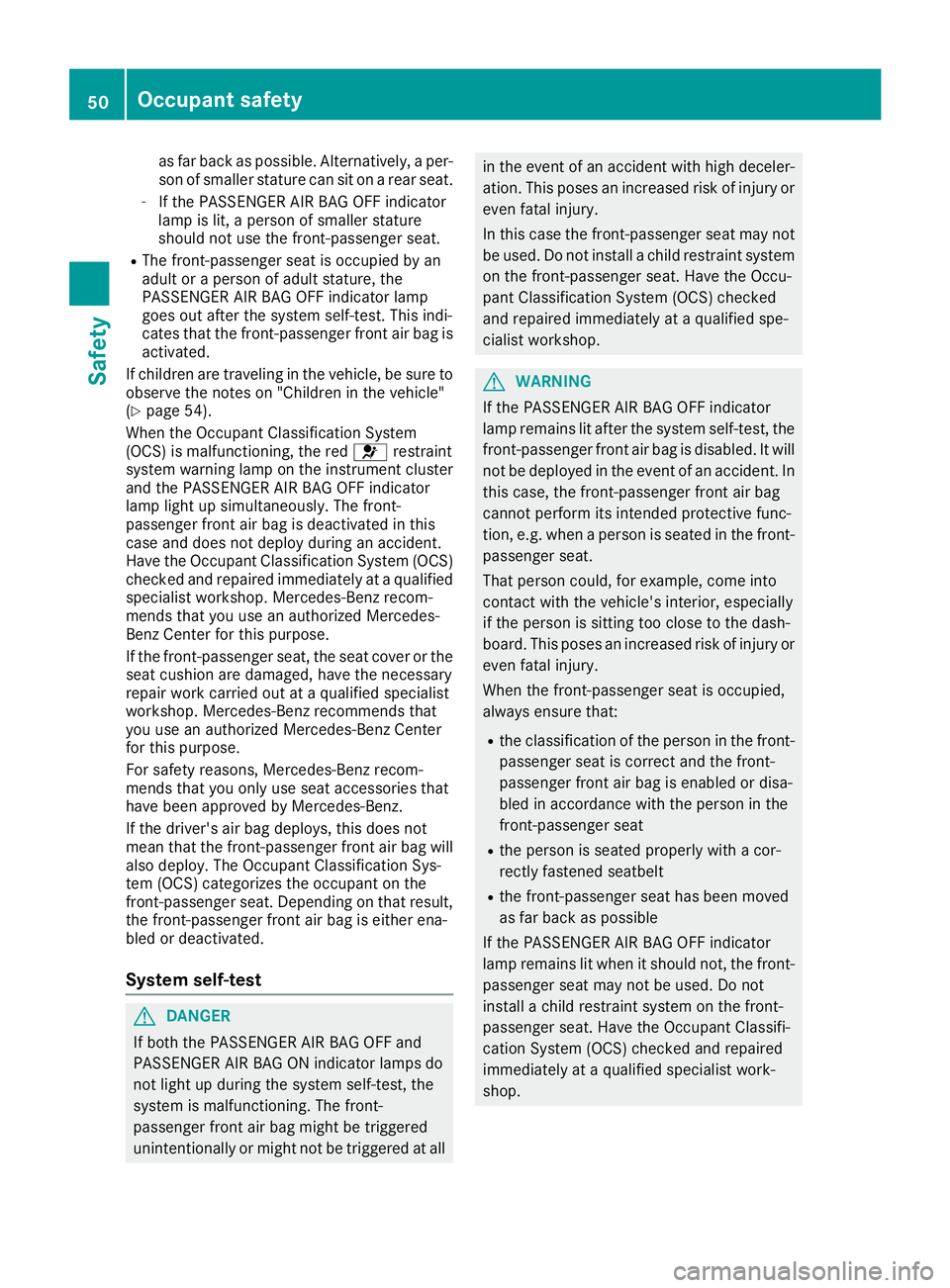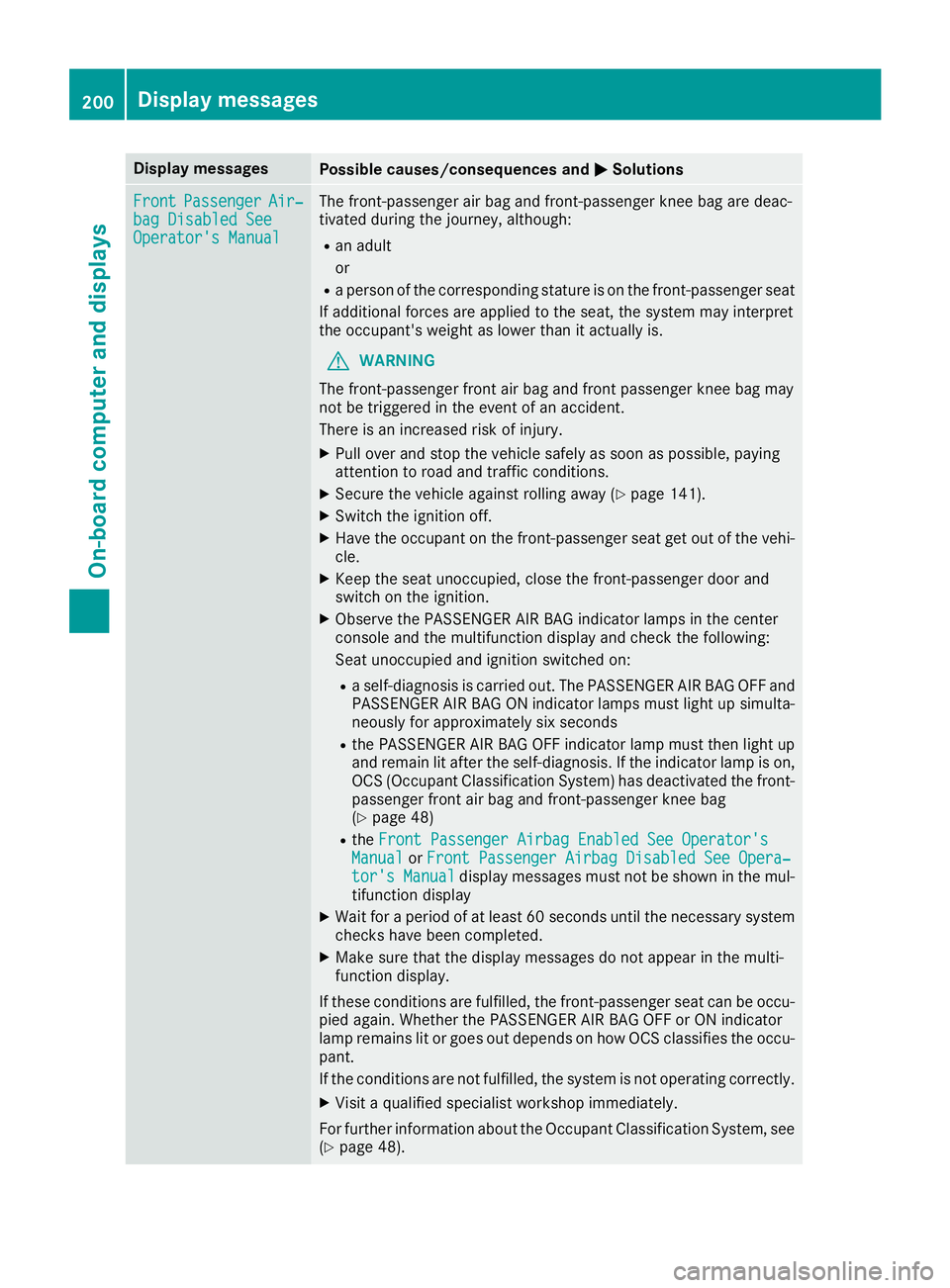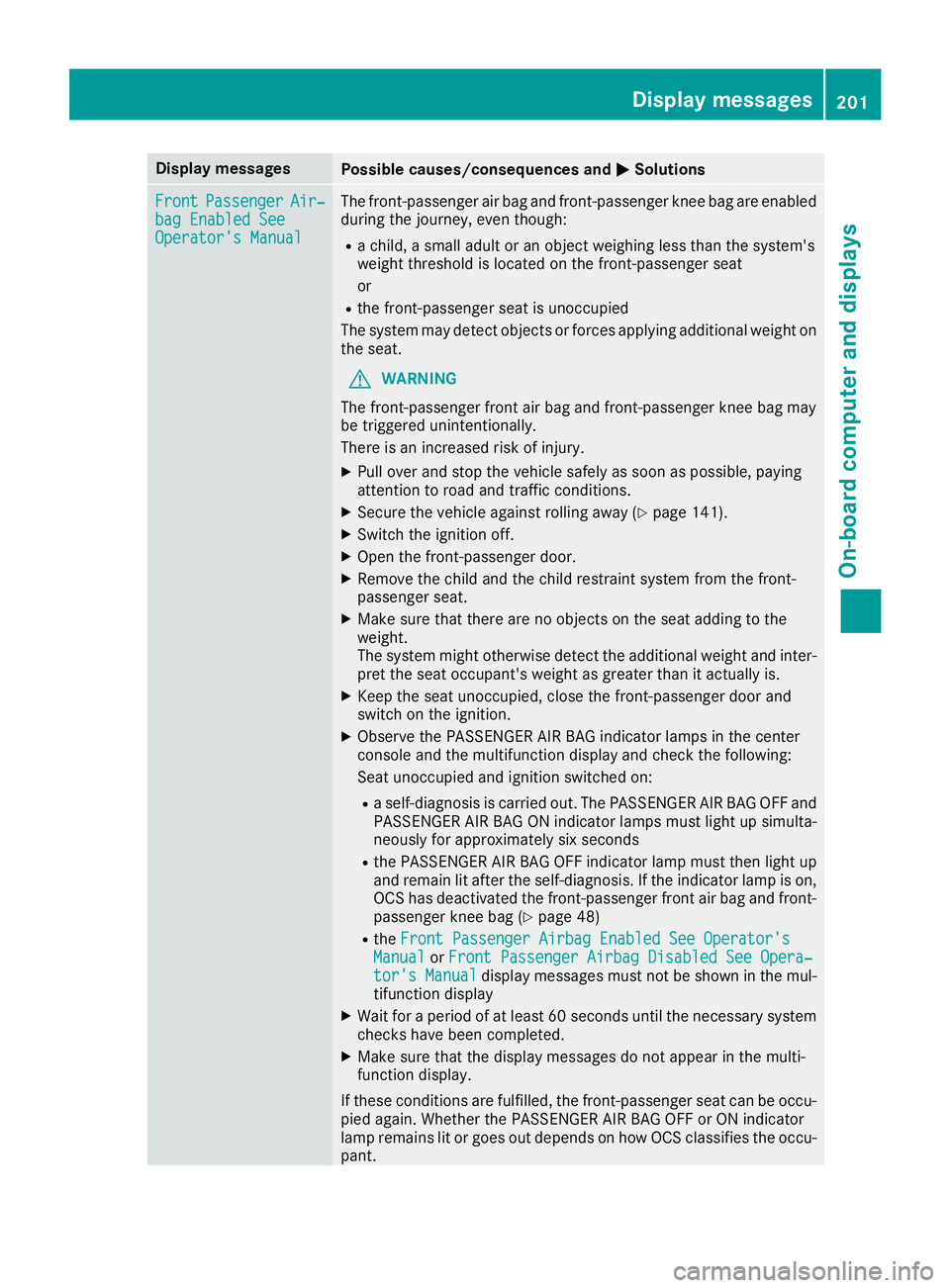2018 MERCEDES-BENZ CLA COUPE deactivate passenger airbag
[x] Cancel search: deactivate passenger airbagPage 47 of 326

seconds or once the driver's seat belt is fas-
tened.
If the vehicle's speed exceeds 15 mph
(25 km/h) once and the driver's and front-
passenger seat belts are not fastened,awarning
tone sounds. Awarning tone also sounds with
increasing intensityf or 60 seconds or until the
driver or front passenger have fastened their
seat belts.
If the driver or front passenger unfasten their
seat belts during the journey, the seat belt warn-
ing is activated again.
Air bags
Introduction
The installation point of an air bag can be rec-
ognized by the AIRBAG marking.
An air bag complements the correctly fastened
seat belt. It is no substitute for the seat belt. The
air bag provides additional protection in appli-
cable accident situations.
Not all air bags are deployed in an accident. The
different air bag systems function independ-
ently from one another (
Ypage 52).
However, no system available today can com-
pletely eliminate injuries and fatalities.
It is also not possible to rule out arisk of injury
caused by an air bag due to the high speed at
which the air bag must be deployed.
Important safety notes
GWARNING
If you do not sit in the correct seat position,
the air bag cannot protect as intended and
could even cause additional injury when
deployed. This poses an increased risk of
injury or even fatal injury.
To avoid hazardous situations, always make
sure that all of the vehicle's occupants:
Rhave fastened their seat belts correctly,
including pregnant women
Rare sitting correctly and maintain the great-
est possible distance to the air bags
Rfollow the following instructions
Always make sure that there are no objects
between the air bag and the vehicle's occu-
pants.
RAdjust the seats properly before beginning
your journey. Always make sure that the seat
is in an almost upright position. The center of
the head restraint must support the head at
about eye level.
RMove the driver's and front-passenger seats
as far back as possible.T he driver's seat posi-
tion must allow the vehicle to be driven safely.
ROnly hold the steering wheel on the outside.
This allowst he air bag to be fully deployed.
RAlways lean against the backrest while driv-
ing. Do not lean forward or lean against the
door or side window. You may otherwise be in
the deployment area of the air bags.
RAlways keep your feet in the footwell in front
of the seat. Do not put your feet on the dash-
board, for example. Your feet may otherwise
be in the deployment area of the air bag.
RFor this reason, always secure persons less
than5ft(1.50 m) tall in suitable restraint sys-
tems. Up to this height, the seat belt cannot
be worn correctly.
If ac hild is traveling in your vehicle,a lso
observe the following notes:
RAlways secure children under twelve years of age and less than 5ft(1.50 m)tallins uitable
child restraint systems.
RChil drestraint systems shoul dbeinstalle don
the rea rseats.
ROnlys ecureac hild in arearward-facing child
restraint systemont he front-passengerseat
when the front-passengerf ront airbag is
deactivated .Ifthe PASSENGER AIR BAG OFF
indicator lamp is permanentl ylit,t he front-
passengerf ront airbag is deactivated
(
Ypage 41).
RAlway sobser ve the instructions and safety
notesont he "Occupant Classification System
(OCS) "(Ypage 47) and on "Children in the
vehicle" (Ypage 54 )ina ddit iontot he child
restraint systemm anufacturer's installation
and operating instructions.
Occupant safety45
Safety
Z
Page 52 of 326

as far back as possible. Alternatively,aper-
son of smaller statur ecan sit on arear seat.
-If th ePASSENG ER AIRBAG OFFi ndicator
lamp is lit,ap erson of smaller stature
shouldn otuse th efront-pa ssenger seat.
RThe front-passenger seat is occupied by an
adult or aperson of adult stature, the
PASSENGER AI RBAG OFFi ndicator lamp
goes out after th esystem self-test.T his indi-
cates that th efront-pa ssenger fronta ir bag is
activated.
If childrena re travelinginthevehicle ,besure to
observ ethe note son" Children in th evehicle"
(
Ypage 54).
When th eOccupan tClassification System
(OCS)ism alfunctioning, th ered 6 restraint
system warning lamp on th einstrumentc luster
and th ePASSENG ER AIRBAG OFFi ndicator
lamp light up simultaneously. The front-
passenger fronta ir bag is deactivate dinthis
cas eand does no tdeployd uringana ccident.
Hav ethe Occupan tClassification System (OCS)
checked and repaired immediately at aqualified
specialist workshop.M ercedes-Benzrecom-
mends that you use an authorized Mercedes-
Ben zCenter for this purpose.
If th efront-pa ssenger seat,t heseat cover or the
seat cushion are damaged, have th enecessary
repai rwork carried out at aqualified specialist
workshop.M ercedes-Benzrecommend sthat
you use an authorized Mercedes-Ben zC
en
ter
for this purpose.
For safety reasons, Mercedes-Ben zrecom-
mends that you only use seat accessories that
have been approved by Mercedes-Benz.
If th edriver'sa ir bag deploys, this does not
mean that th efront-pa ssenger fronta ir bag will
also deploy. The Occupan tClassification Sys-
te m( OCS)c ategorize sthe occupant on the
front-passenger seat.D ependingont hatresult,
th ef ront-pa ssenger fronta ir bag is either ena-
bled or deactivated.
System self-test
GDANGER
If botht hePASSENGER AI RBAG OFFa nd
PASSENGER AI RBAG ON indicator lamps do
no tlight up durin gthe system self-test,t he
system is malfunctioning. The front-
passenger fronta ir bag mightbetriggered
unintentionally or mightn otbe triggered at all
in th eeven tofana ccidentw ith high deceler-
ation. This posesani ncreased risk of injury or
even fatal injury.
In this cas ethe front-passenger seat may not
be used. Do no tinstall achild restraint system
on th efront-pa ssenger seat.H avet he Occu-
pant Classification System (OCS)c hecked
and repaired immediately at aqualified spe-
cialis tworkshop.
GWARNING
If th ePASSENG ER AIRBAG OFFi ndicator
lamp remains lit after th esystem self-test,t he
front-passenger fronta ir bag is disabled. It will
no tbed eployed in th eeven tofana ccident. In
this case, th efront-pa ssenger fronta ir bag
canno tperform its intended protective func-
tion, e.g .when aperson is seated in th efront -
passenger seat.
That person could, for example, com einto
contac twith th evehicle's interior, especially
if th eperson is sittin gtoo close to th edash-
board .This posesani ncreased risk of injury or
even fatal injury.
When th efront-pa ssenger seat is occupied,
always ensure that:
Rth ec lassification of th eperson in th efront -
passenger seat is correc tand th efront -
passenger fronta ir bag is enabled or disa-
bled in accordance with th eperson in the
front-passenger seat
Rth ep erson is seated properly with acor-
rectly fastene dseatbelt
Rthef ront-pa ssenger seat has been moved
as far back as possible
If th ePASSENG ER AIRBAG OFFi ndicator
lamp remains lit when it shouldn ot,the front-
passenger seat may no tbeused. Do not
install achild restraint system on th efront -
passenger seat.H avet he Occupan tClassifi-
cation System (OCS)c hecked and repaired
immediately at aqualified specialist work-
shop.
50Occupant safety
Safety
Page 202 of 326

Display messagesPossible causes/consequences andMSolutions
FrontPassengerAir‐bag Disabled SeeOperator' sManual
The front-passenger air bag and front-passenger knee bag are deac -
tivated during th ejou rney, although:
Ran adult
or
Rap erson of th ecorre spondin gstatur eisont hefront-passenger seat
If additional force sare applie dtotheseat ,the system may interpret
th eo ccupant's weigh taslower than it actually is.
GWARNIN G
The front-passenger fron tair bag and fron tpassenger knee bag may
no tbet riggered in th eevent of an accident.
There is an increased ris kofinjury.
XPull ove rand stop th evehicl esafely as soo naspossible, payin g
attention to roa dand traffic conditions.
XSecur ethe vehicl eagainst rollin gaway (Ypage 141).
XSwitc hthe ignition off .
XHavethe occupant on th efront-pa ssenger seat get out of th evehi-
cle .
XKee pthe seat unoccupied ,close th efront-pa ssenger door and
switch on th eignition .
XObserv ethe PASSENGER AI RBAG indicator lamp sinthecenter
console and th emultifunction display and chec kthe following:
Seat unoccupied and ignition switched on :
Raself-diagnosis is carrie dout.T he PASSENGER AI RBAG OFFa nd
PASSENGER AI RBAG ON indicator lamp smustligh tups imulta-
neousl yfor approximately six seconds
RtheP ASSENG ER AIRBAG OF Findicator lamp mus tthe nligh tup
and remain lit after th eself-diagnosis .Iftheindicator lamp is on ,
OCS (Occupant Classification System) has deactivated th efront -
passenger fron tair bag and front-passenger knee bag
(
Ypage 48)
Rth eFront Passenger Airbag Enable dSee Operator' sManualorFront Passenger Airbag Disabled See Opera‐tor's Manualdisplay message smustn otbe shown in th emul-
tifunction display
XWait for aperiod of at least 60 seconds until th eneces sarysystem
checks hav ebeen completed.
XMak esuret hatthe display message sdonotappear in th emulti-
function display.
If these condition sare fulfilled ,the front-passenger seat can be occu-
pied again .Whether th ePASSENG ER AIRBAG OFForONi ndicator
lamp remain slit or goe sout depend sonhow OCS classifies th eoccu-
pant.
If th econditi onsa re no tfulfilled ,the system is no toperating correctly.
XVisit aqualified specialist workshop immediately.
Fo rfurther information about th eOccupant Classification System, see
(
Ypage 48) .
200Display messages
On-boardc omputer andd isplays
Page 203 of 326

Display messagesPossible causes/consequences andMSolutions
FrontPassengerAir‐bag Enable dSeeOperator' sManual
The front-passenger air bag and front-passenger knee bag are enabled
during th ejou rney, eve nthough :
Rachild, asmall adult or an objec tweighing less than th esystem' s
weigh tthreshold is locate donthefront-passenger seat
or
Rth ef ront-pa ssenger seat is unoccupied
The system may detec tobjects or force sapplyin gadditional weigh ton
th es eat .
GWARNIN G
The front-passenger fron tair bag and front-passenger knee bag may
be triggered unintentionally.
There is an increased ris kofinjury.
XPull ove rand stop th evehicl esafely as soo naspossible, payin g
attention to roa dand traffic conditions.
XSecur ethe vehicl eagainst rollin gaway (Ypage 141).
XSwitc hthe ignition off .
XOpenthe front-passenger door .
XRemove thechild and th echild restrain tsystem from th efront -
passenger seat .
XMakesuret hatthe re are no objects on th eseat addin gtothe
weight.
The system might otherwise detec tthe additional weigh tand inter-
pre tthe seat occupant's weigh tasgreatertha nita ctually is.
XKeepthe seat unoccupied ,close th efront-pa ssenger door and
switch on th eignition .
XObserv ethe PASSENGER AI RBAG indicator lamp sinthecenter
console and th emultifunct ion display and chec kthe following:
Seat unoccupied and ignition switched on :
Raself-diagnosis is carrie dout.T he PASSENGER AI RBAG OFFa nd
PASSENGER AI RBAG ON indicator lamp smustligh tups imulta-
neousl yfor approximately six seconds
RtheP ASSENG ER AIRBAG OFFindicator lamp mus tthe nligh tup
and remain lit after th eself-diagnosis .Iftheindicator lamp is on ,
OCS has deactivated th efront-pa ssenger fron tair bag and front-
passenger knee bag (
Ypage 48)
RtheFront Passenger Airbag Enable dSee Operator' sManualorFront Passenger Airbag Disabled See Opera‐tor's Manualdisplay message smustn otbe shown in th emul-
tifunction display
XWait for aperiod of at least 60 seconds until th eneces sarysystem
checks hav ebeen completed.
XMak esuret hatthe display message sdonotappear in th emulti-
function display.
If these condition sare fulfilled ,the front-passenger seat can be occu-
pied again .Whether th ePASSENG ER AIRBAG OFForONi ndicator
lamp remain slit or goe sout depend sonhow OCS classifies th eoccu-
pant.
Display messages20 1
On-boardc omputer andd isplays
Z